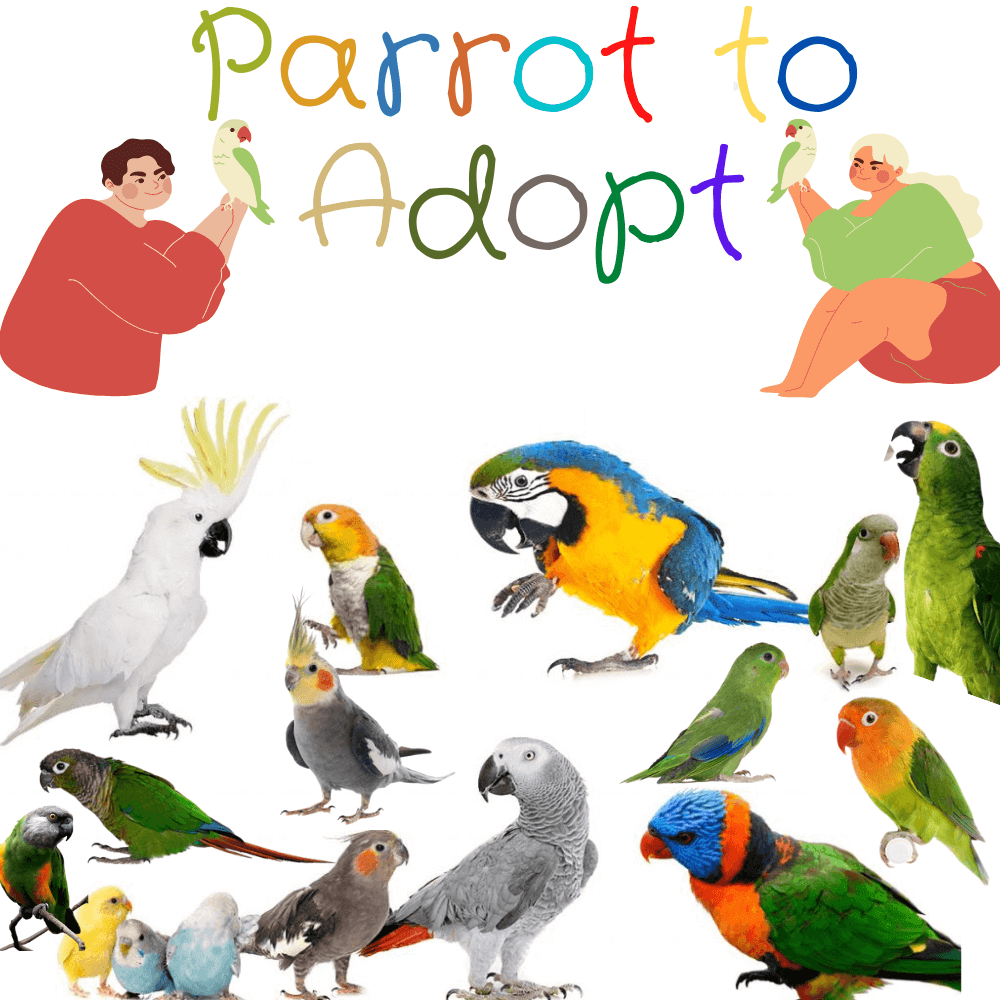
Parrot to adopt: With his talents for chatting, but also for learning many other things, the parrot has made a place for itself in the hearts of many masters. But be careful before choosing yours, because not all species of parrots have the same needs. And some can live for several decades!
Adopting a parrot a real commitment
The parrot is a somewhat exclusive animal
How not fall in love with this fascinating bird that is the parrot? Although this family is divided into several subspecies with relatively different character traits, parrots all have in common their exotic appearance and learning abilities that make them unique.
Educating your parrot is not an option but an obligation
So make sure you have time for it every day. Parrot education is first and foremost about words, but not only. Some breeds of parrots enjoy antics, dancing to music, and even showing off rude humor.
If you do not regularly take him out of his Parrot cage (different daily duration depending on the breed of the parrot) to play with him and teach him things, your animal will become depressed, to the point sometimes of no longer eating.
Should I adopt a parrot?
What are the friendliest parrots?
What is the smallest species of parrot?
Special attention
Just like a dog, the parrot needs the attention of its owner. And in return, he knows how to give affection and laughter to the whole family. However, it remains a somewhat exclusive animal. Above all, he will recognize the person who takes care of him every day. This is called preferential association.
Ask yourself the question of the adult size of your parrot. Do you have enough room to install a cage spacious enough for him?
Finally, don’t forget that adopting a parrot represents a very long-term commitment. For example, the lifespan of an African gray parrot is 50 years on average. Happy and well cared for, some individuals have even reached their 80s!
Great Parrots for A Beginner
SOURCE:Victoria Ryann
Good to know: parrots are victims of numerous trafficking and are sometimes taken illegally from the wild. Never buy a parrot without having all the papers authenticating its origin in breeding.
Some particularly endangered species of parrot must be ringed by breeders.
Adopt African Grey Parrot

Parrot to adopt
The African grey parrot, its real name Congo African grey parrot, is a truly exceptional bird. In his deep gray dress from which protrudes a red tail, he has no doubts about his natural elegance.
Particularly sociable, with other parrots as with humans, he is recognized as the most intelligent of parrots (his intelligence would be comparable to that of a 5-year-old child)like Timneh parrot. Its upbringing goes beyond anything other parrots are capable of.
African Gray is able to memorize around 200 words. But he doesn’t content himself with repeating them in a random fashion, he knows how to place them in their context, which gives rise to situations as funny as they are marked by complicity.
It is also able to reproduce wonderfully well the sounds that it hears regularly, such as the ringing of the telephone or the doorbell.
Be careful, the Congo African gray is a fairly large bird: more than 40 cm in adulthood. A cage of at least 90 cm wide by 120 cm high is necessary. Bigger is even better! This exceptional parrot has a lifespan of 50 to 80 years.
It is therefore a lifelong commitment for those who decide to embark on the adventure.
The Amazon parrot

Parrot to adopt
Adopt Amazon Parrot
The Amazon is the parrot that adorns the shoulder of any self-respecting pirate. Its green plumage, large beak, and stocky body make it immediately identifiable. However, the colors it wears on the cheeks and the skull make it possible to differentiate the subspecies (numbering 27) which each has a slightly different character.
Amazon parrots grow to around 35cm in adulthood and can live between 40 and 50 years, or even longer. Among the most popular Amazon varieties are the blue-fronted Amazon parrot and the red-fronted Amazon.
He will appreciate living in a relationship.
Blue-fronted Amazon
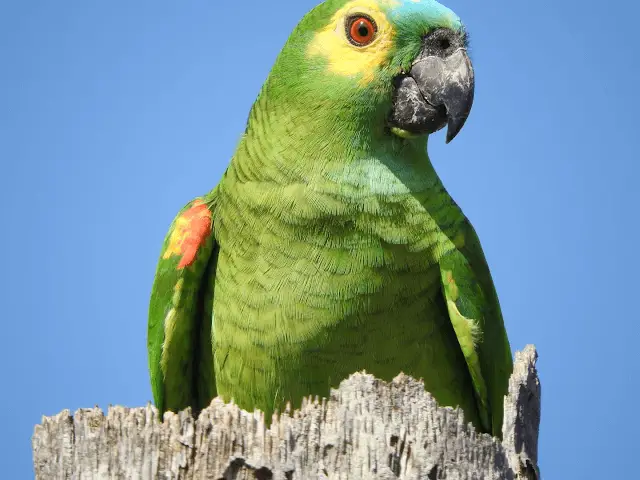
If you are looking for a little fun kid ready to dance on the table and do some nice silly things, the Blue-fronted Amazon parrot is for you. Always ready to have fun, it will delight young and old.
This parrot needs a lot to get out of its cage. He particularly enjoys building his legs through balance exercises that you have concocted for him.
If he is gregarious in the wild, meeting the partner or partner with whom he will spend his entire life creates a special relationship, completely apart from the rest of the group.
And he reproduces this “preferential association” with his master, which is particularly endearing, but in fact, entails an additional responsibility for the latter.
It is therefore a bird to avoid if you are often absent. In any case, the blue-fronted Amazon will greatly appreciate sharing its cage with a congener of the opposite sex.
An acrobat ready to make you laugh
Red-lored amazon
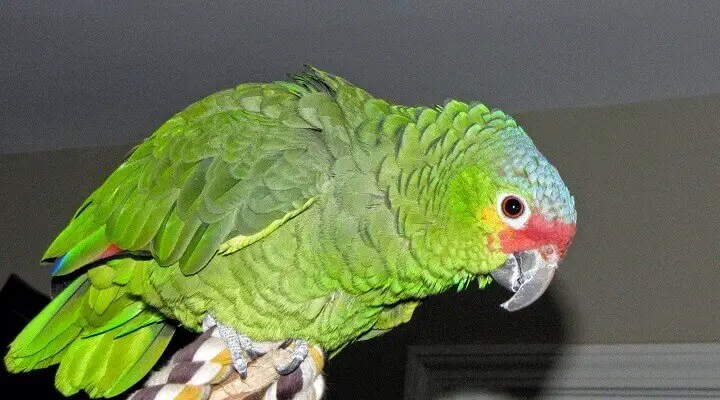
Red-lored amazon will tolerate better being alone in a cage, always on condition that his master grants him at least one to two hours of outings per day in order to allow him to play and exercise.
Because like all Amazons, the Red Front is a rascal. He will not hesitate to try new acrobatics and will reproduce them if he notices that they make you laugh. A little quieter than its blue-fronted cousin, it is more suitable if you have neighbors sensitive to noise.
Adopt Cockatoo
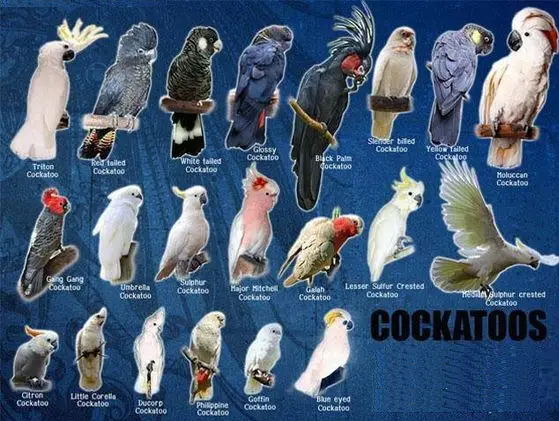
Parrot to adopt
Particularly active and noisy, the cockatoo is not recommended if you are looking for calm at home. On the other hand, if you want to own a parrot with a strong character and who likes to bite into life, then the cockatoo is for you.
His crest which rises and falls on its head according to its moods (and not when it is about to “attack” as the legend wants it) is a spectacle in itself.
Make no mistake, all of this commotion that the cockatoo creates is not provocation, but just fun for him. A certain firmness in education, indicated by the tone of voice only, may be necessary to restore some calm. You will understand that adopting a cockatoo parrot is not easy, but the happiness that this brings is priceless.
The size of the cockatoo will depend on the species it comes from. The white-crested cockatoos are the largest specimens with a height of 50 cm. The life expectancy of this little party animal is around thirty years. Enough to give him time to become a real member of the family.
Adopt Lovebirds
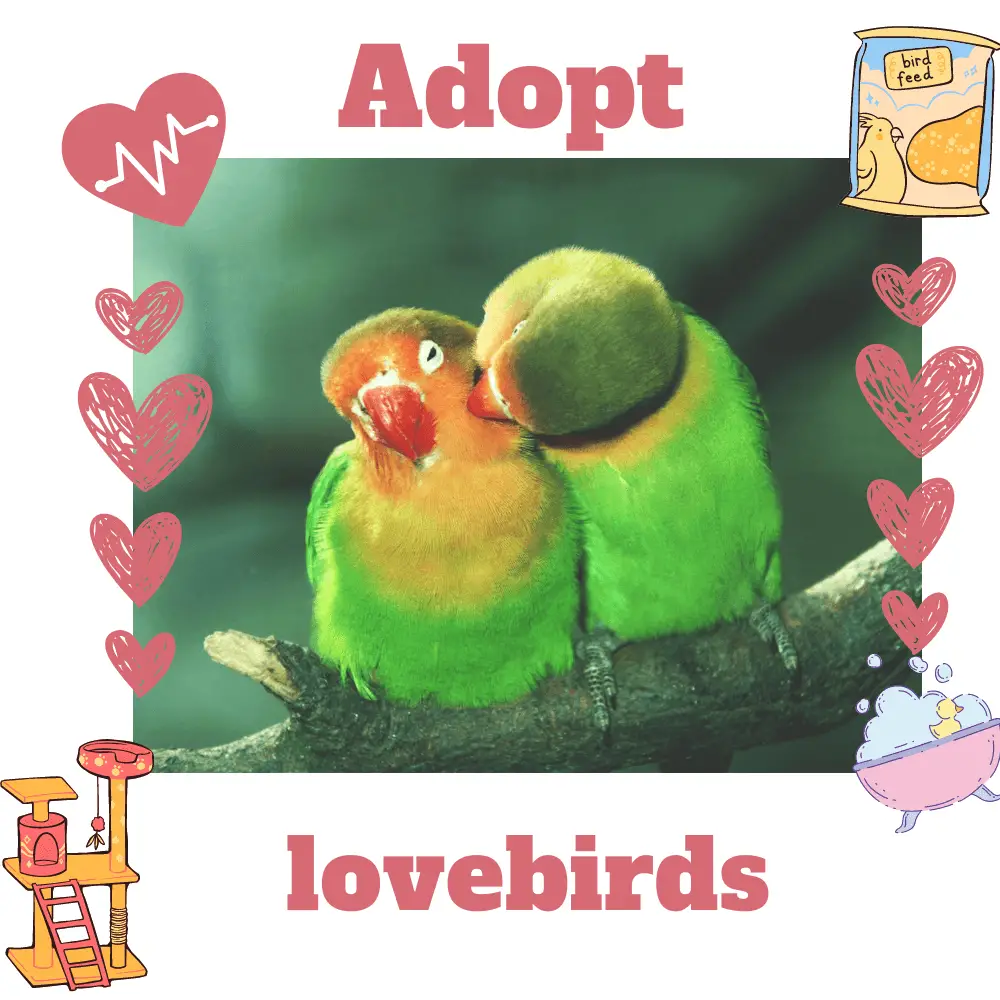
Adopting a parrot
Lovebirds are small African birds but they tolerate a temperate climate well.
As the name suggests, they love to live in company. Fortunately, they are accommodating a family of human adoption.
Their cage should have a square or rectangular bottom because round cages are not suitable for them. Put them perches of different diameters, without sandpaper.
Place the cage away from drafts and direct sunlight. Cleans the bottom of the cage and perches every day. Every week, spend the empty cage in the shower to clean it well.
Teach your Lovebirds to get out of their cage, closing the windows well! Let them out once a day. But at night, assure them 12 to 14 hours of calm, without electric light, covering their cage with a thick and black fabric.
Every day, wash their trough and change the water so that it is clean and fresh. Give them suitable food. No seeds or treats for parakeets.
You can also give them well-washed and dried fruits and vegetables, but avoid onion, potato, mushrooms, avocado.
Give them softwood to wear out their beaks and toys like bells, swings, rings big enough. Don’t put mirrors on them.
Well cared for, the Lovebird can live 15 years!
Adopt Cockatiel

Adopting a parrot
A true mini cockatoo, the cockatiel parakeet or Nymphicus hollandicus is a small Australian parakeet.
A tame parakeet is a parakeet that was raised “by hand”, which means that it was fed by man and not by his parents. Because of this, the bird is immediately familiar, it comes on its owners, asks for caresses, kisses. A tame parakeet represents a real companion as soon as it arrives.
The Aprivoisiée cockatiel is undoubtedly the most docile bird in its category!
Who is she?
Colour:
Several chromatic variants exist the white-faced cockatiel, the pearl cockatiel…
Waist:
30-35 cm long and a pretty erectile hoopoe on the head
Life expectancy:
Between 10 and 15 years old
Reproduction:
- Sexual maturity: 6 months
- 4/6 eggs
How to take care of it?
Your parakeet must be installed in a cage as spacious as possible. Like all birds, the cockatiel parakeet fears drafts! So pay attention to the location of the cage and especially when you take it on a trip.
The perches must be of different diameters in order to “work” the paws of your companion.
Toys adapted to their size must be installed in the cage in order to compensate for boredom and to wear out the beak.
Its diet
The basic diet should be a mixture of seeds for large parakeets of good quality. Be careful, “cheap” foods are usually too fatty.
Add to this piece of fruit and vegetables, the apple remaining his favorite fruit! Millet clusters will be appreciated. And, of course, provide a container of water and a cuttlefish bone as well as a “skewer” of seeds to the shell. An iodized mineral block will be welcome.
As with all Psittacides, it is strongly discouraged, or even prohibited, to give him parsley to consume.
Care and hygiene
A bathtub will be necessary for it to bathe, however familiar parakeets love to shower at the tap when they go out. Pay attention to the temperature of the water. In summer, a mist with a plant sprayer will refresh your companion.
List of parrots to adopt
| Species | Life expectancy |
| Amazon Parrot | 50 – 60 ans |
| Macaws Parrot | 50 -70 ans |
| Ara Ararauna | 50 – 70 ans |
| Red-and-green macaw | 50 – 70 ans |
| Hyacinth macaw | 30 – 40 ans |
| Blue-winged macaw or Maracana | 50 – 70 ans |
| Scarlet Macaw | 30 – 40 ans |
| Red-shouldered macaw | 30 – 40 ans |
| Chestnut-fronted macaw | 40 – 50 ans |
| Cockatoo with the naked eye | 50 – 60 ans |
| Yellow-crested cockatoo | 50 – 60 ans |
| Salmon-crested cockatoo | 40 – 50 ans |
| Tanimbar corella | 30 – 40 ans |
| Galah | 20 – 30 ans |
| Caique | 18 – 25 ans |
| Cockatiel | 20 – 30 ans |
| Conure | 20 – 30 ans |
| Green-cheeked parakeet | 20 – 30 ans |
| Burrowing parrot | 20 – 30 ans |
| Jandaya parakeet | 20 – 30 ans |
| Nanday parakeet | 50 – 80 ans |
| Sun conure | 50 – 70 ans |
| Eclectus parrot | 30 – 35 ans |
| Grey parrot | 40 – 60 ans |
| Lovebird | 10 – 15 ans |
| Red-fronted parrot | 60 – 65 ans |
| kakariki | 10 – 15 ans |
| Loriinae | 10 – 20 ans |
| Meyer’s parrot | 15 – 20 ans |
| Brown-headed parrot | 20 – 30 ans |
| Red-bellied parrot | 25 -35 ans |
| Rose-ringed parakeet | 20 -30 ans |
| Alexandrine parakeet | 30 -40 ans |
| Bourke’s parrot | 20 – 25 ans |
| Elegant parrot | 10 – 15 ans |
| Pionus | 20 – 25 ans |
| Monk parakeet | 15 – 25 ans |
| Rosellas | 10 – 15 ans |
| Pacific parrotlet | 15 – 20 ans |
| Senegal parrot | 20 -30 ans |




















